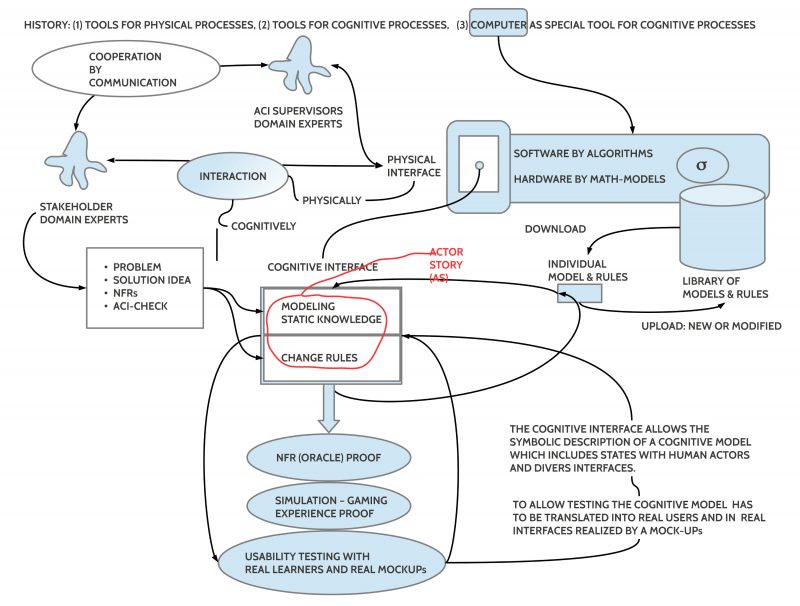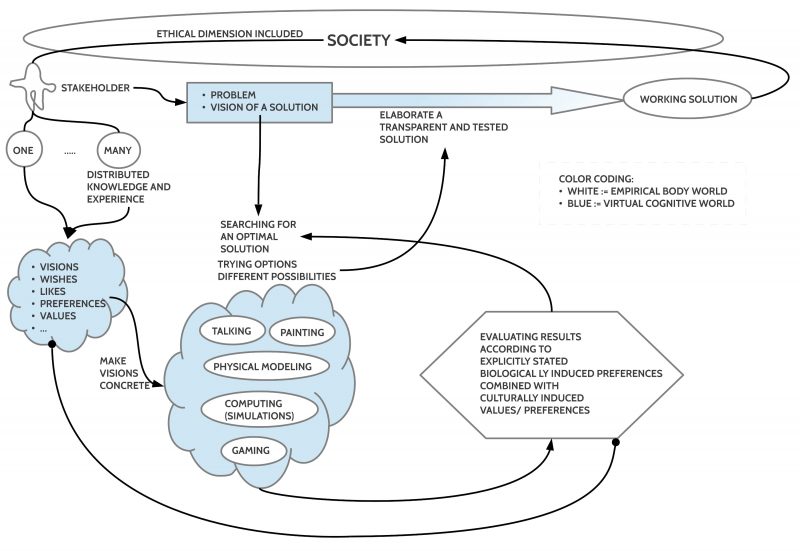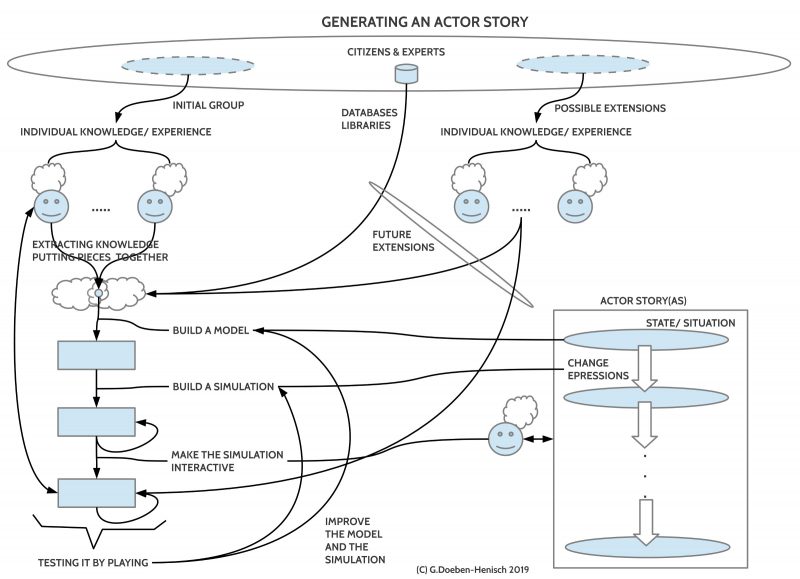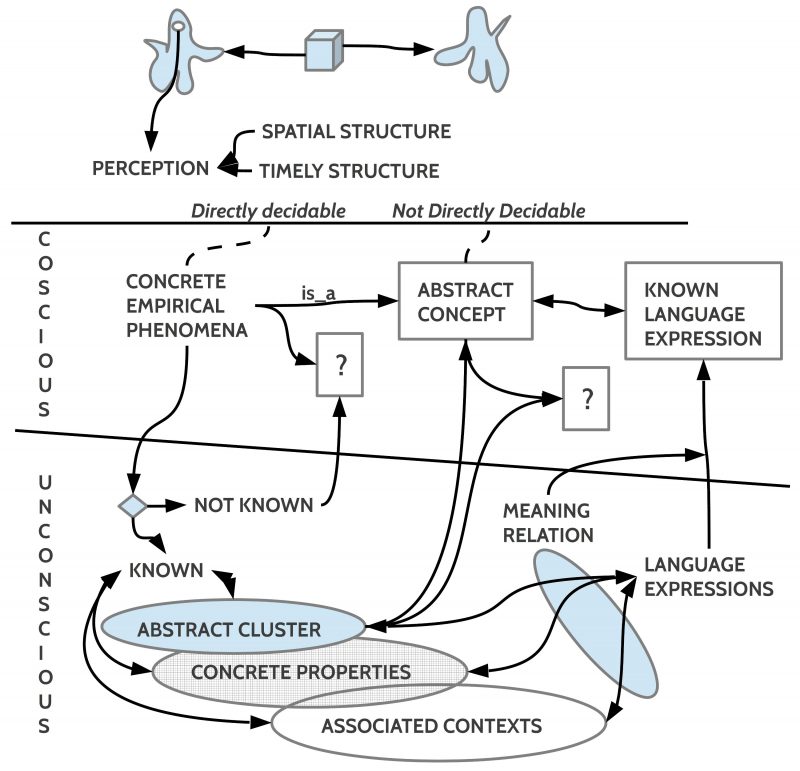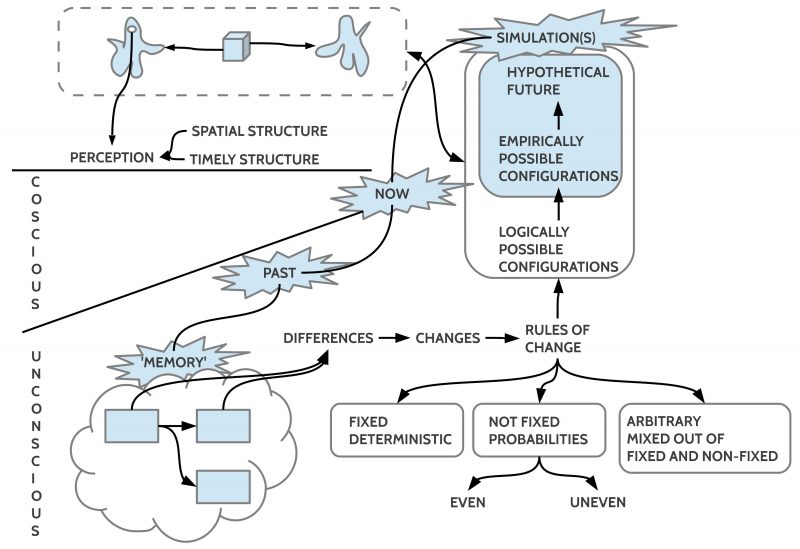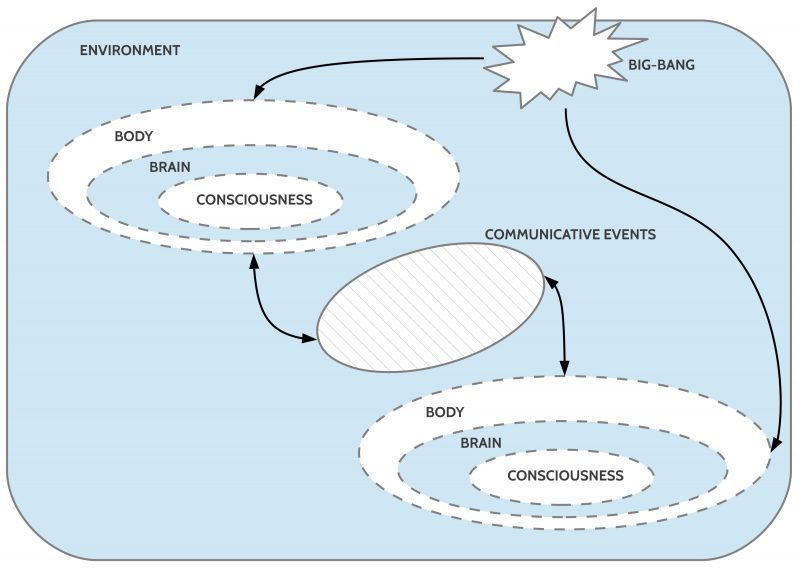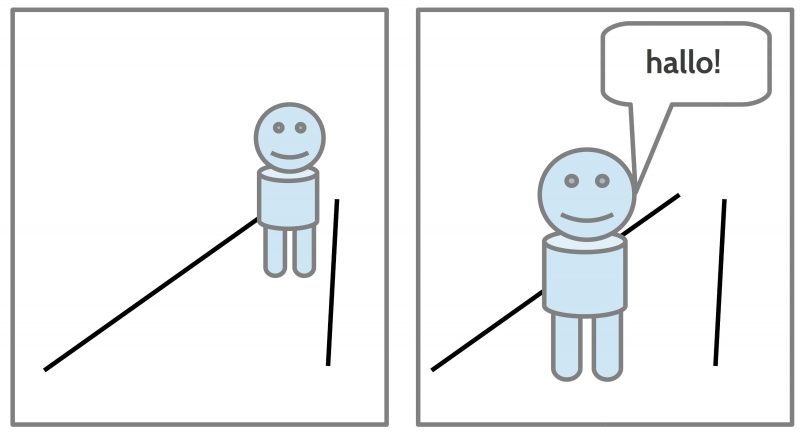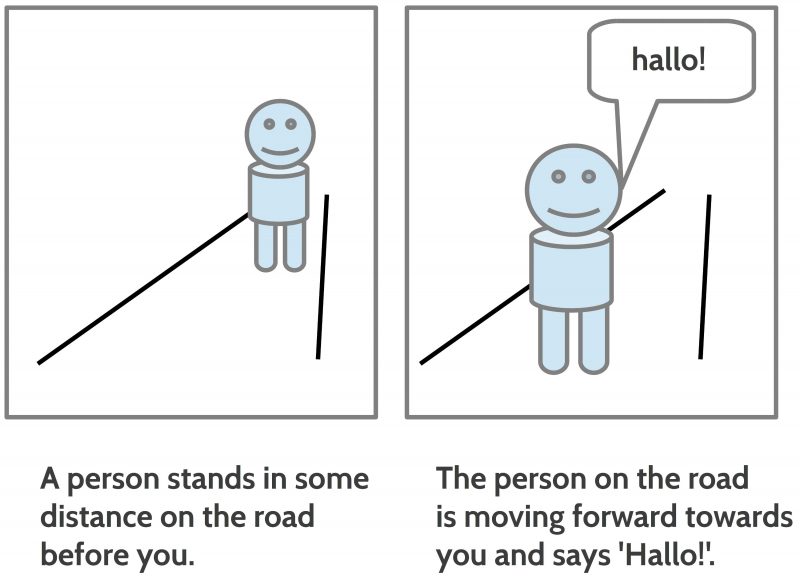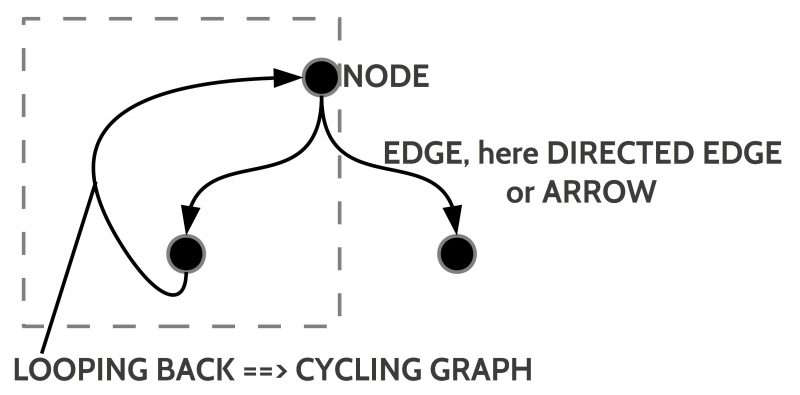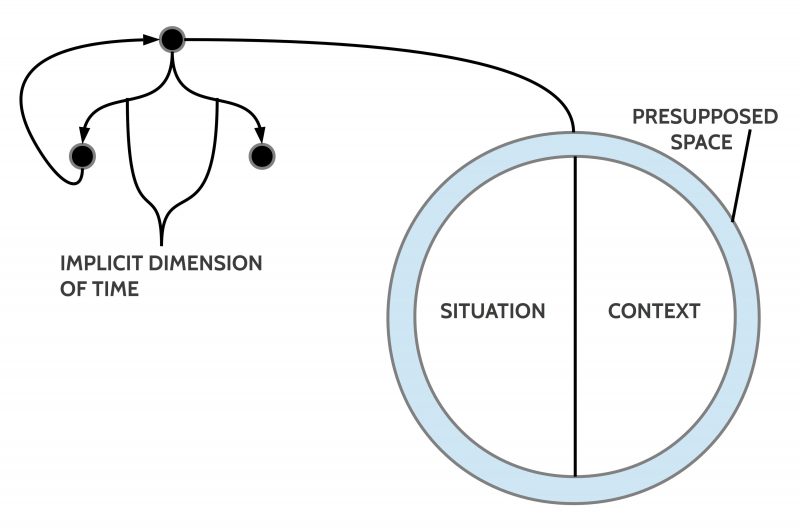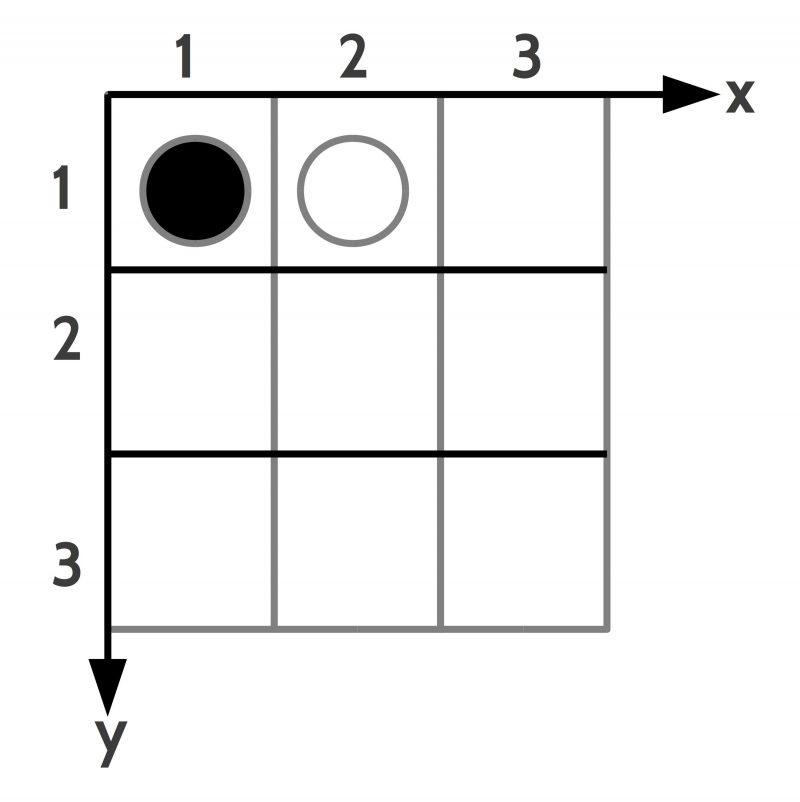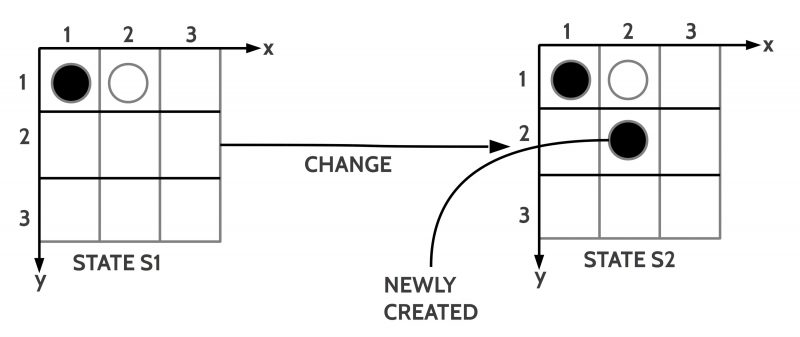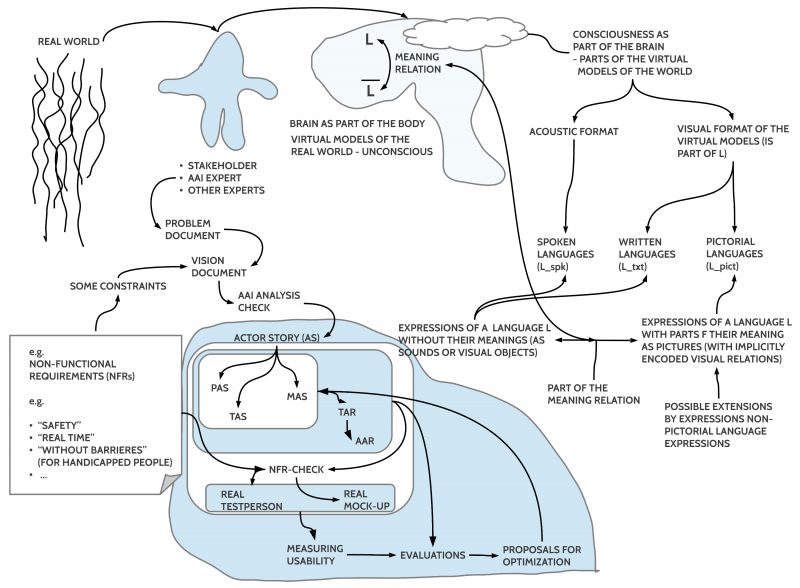eJournal: uffmm.org
ISSN 2567-6458, 13.Januar 2023 – 18.January 2023, 08:08 p.m.
Email: info@uffmm.org
Author: Gerd Doeben-Henisch
Email: gerd@doeben-henisch.de
Parts of this text have been translated with www.DeepL.com/Translator (free version), afterwards only minimally edited.
CONTEXT
This post is part of the book project ‘oksimo.R Editor and Simulator for Theories’.
Part 2
( This text is an direct continuation of the text “The ‘inside’ of the ‘outside’. Basic Building Blocks”)
Establishment of First Structures
At first sight, the previously described galactic cell association of a human body does not provide a natural clue for a ‘center’ of some kind. Which cell should be more important than others? Each one is active, each one does its ‘job’. Many ‘talk’ to many. Chemical substances are exchanged or by means of chemical substance exchange ‘electrical potentials’ are generated which can travel ‘faster’ and which can generate ‘impulse-like events’ which in turn activate chemical substances again. If one would make this ‘talking with chemical substances and electric potentials’ artificially audible, we would have a symphony of 127 trillion (127 x 10^12) single voices …
And yet, when we experience our human bodies in everyday life, we don’t see a huge cloud of galactic proportions of individual cells, we see a ‘delineated object’ with a surface that is ‘visible’; an object that can make ‘sounds’, that ‘smells’, that is ‘touchable’, that can ‘change’ and ‘move’. Moreover, it can ‘stuff things into itself’, and ‘gases’, ‘liquids’, and ‘more solid components’ also come out of it. Further it is obvious with longer observation that there are areas at the body which react to ‘light’ (eyes), to ‘sounds’ (ears), to ‘smells’ (nose), to ‘touch’ (skin), to ‘body positions’ (among other things sense of balance), to ‘temperature’ (skin), to ‘chemical compositions of substances in the mouth’ (taste organs in the mouth) and some more.
This everyday ‘experience’ suggests the assumption that the cells of our human body have spatially arranged themselves into ‘special networks’ [1], which show a high ‘degree of organization’, so pronounced that these networks appear like ‘one unit’, like a ‘single system’ with ‘input’ and ‘output’, and where complex processes take place between input and output. This opens up the possibility of viewing the galactic space of autonomous cells in a human body as a ‘collective of organized systems’ that appear to be in active exchange with each other.”[2], [4],[5]
In modern technical systems such as a car, an airplane, a computer, there is a ‘meta-level’ from which the whole system can be ‘controlled’. In the car the steering wheel, the brake, the gear shift etc., similarly in the airplane the cockpit with a multiplicity of instruments, or with the computer the input and output devices. However, for years an increasing ‘autonomy’ of these technical devices has been emerging, insofar as many control decisions of humans are shifted to ‘subsystems’, which thereby ‘self-perform’ more and more classical control performance of humans.[6].
In a human body there exists ‘parallel’ to the different body systems among other things the ‘nervous system’ with the ‘brain’ as central area, in which many ‘signals from the body systems’ run together and from which again ‘signals to the body systems’ are sent out. The brain with the nervous system seems to be a system of its own, which processes the incoming signals in different ‘neuronal processes’ and also sends out signals, which can cause ‘effects in the body systems’.[7] From the point of view of ‘functioning’ the brain with the nervous system can be understood as a kind of ‘meta-system’, in which properties of all other ‘body systems’ are ‘mapped’, find a ‘process-like interpretation’, and can be influenced (= ‘controlled’) to a certain degree with the help of these mappings and interpretations.
As the modern empirical sciences make visible more and more by their investigations and subsequent ‘interpretations’ (e.g. [4],[5]), the distinguishable body systems themselves have a very high complexity with their own ‘autonomy’ (stomach, liver, kidney, heart, …), which can be influenced only conditionally by the brain, but which conversely can also influence the brain. In addition, there is a hardly manageable amount of mutual influences via the immense ‘material flows’ in the blood circulation and in the body fluids.
For the context of this book, of particular interest here are those structures that are important for the ‘coordination of the different brains’ by means of ‘language’ and closely related to this are the ‘cognitive’ and ’emotional’ processes in the brain that are responsible for what ‘cognitive images are created in the mind’ with which a brain ‘interprets’ ‘itself’ and ‘everything else’.
How to describe the Human Being?
The description of the human cell galaxy as ‘subsystems’ with their own ‘input’ and ‘output’ and and including ‘inner processes’ – here simply called the ‘system function’ – can appear ‘simple’ at first sight, ‘normal’, or something else. We enter with this question the fundamental question, how we can describe the human cell galaxy – i.e. ‘ourselves’! – at all and furthermore maybe how we ‘should’ describe it: are there any criteria on the basis of which we should prefer a ‘certain way of description’?
In the case of the description of ‘nature’, of the ‘real world’, we may still be able to distinguish between ‘us’ and ‘nature’ (which, however, will later come out as a fallacy)), it becomes somewhat more difficult with the ‘description of ourselves’. If one wants to describe something, one needs certain conditions to be able to make a description. But what are these conditions if we want to describe ourselves? Doesn’t here the famous ‘cat bite into its own tail’?
In ‘normal everyday life’ [8] typical forms with which we describe are e.g. ‘pictures’, ‘photographs’, ‘videos’, ‘music’, ‘body movements’ and others, but above all linguistic expressions (spoken, written; everyday language, technical language; …).
Let’s stay for a moment with ‘everyday language (German, English, Italian, …).
As children we are born into a certain, already existing world with a respective ‘everyday life’ distinctive for each human person. At least one language is spoken in such an environment. If the parents are bilingual even two languages in parallel. If the environment is different from the language of the parents, then perhaps even three languages. And today, where also the environment becomes more and more ‘multi-cultural’, maybe even more than three languages are practiced.
No matter how many languages occur simultaneously for a person, each language has its own ‘rules’, its own ‘pronunciation’, its own ‘contextual reference’, its own ‘meanings’. These contexts can change; the language itself can change. And if someone grows up with not just one language, but more than one, then ‘in the person’, in the ‘speaker-listener’, there can naturally be multiple interactions between the different languages. Since this happens today in many places at the same time with more and more people, there are still hardly sufficient research results available that adequately describe this diversity in its specifics.
So, if we want to describe ‘ourselves’ as ‘part of the real world’, we should first of all accept and ‘consciously assume’ that we do not start at ‘point zero’ at the moment of describing, not as a ‘blank sheet’, but as a biological system which has a more or less long ‘learning process’ behind it. Thereby, the word ‘learning process’ as part of the language the author uses, is not a ‘neutral set of letters’, but likewise a ‘word’ of his language, which he shares with many other speakers of ‘German’. One must assume that each ‘speaker of German’ associates his own ‘individual conceptions’ with the word ‘learning process’. And also this word ‘conception’ is such a word, which as part of the spoken (and written) language normally does not come along ‘meaning-free’. In short, as soon as we speak, as soon as we link words in larger units to statements, we activate a set of ‘knowledge and skills’ that are somehow ‘present in us’, that we use ‘automatically’, and whose use is normally largely ‘unconscious’.”[9],[10]
When I, as the author of this text, now write down statements in the German language, I let myself be carried by a ‘wave of language usage’, so to speak, whose exact nature and effectiveness I cannot fully grasp at the moment of use (and this is the case for every language user). I can, however, when I have expressed myself, look more consciously at what has been expressed, and then — perhaps — see clearer whether and how I can place it in contexts known to me. Since also the ‘known to me’ is largely ‘unconscious’ and passes from ‘unconscious knowledge’ into ‘conscious’ knowledge, the task of a ‘clarification of speaking’ and the ‘meaning’ connected with it is always only fragmentarily, partially possible. The ‘conscious eye of knowledge’ is therefore perhaps comparable to a ‘shining knowledge bubble’ in the black sea of ‘unconscious knowledge’, which seems to be close to ‘not-knowing’ but it isn’t ‘not-knowing’: ‘unconscious knowledge’ is ‘inside the brain ‘real knowledge’, which ‘works’.
… to be continued …
COMMENTS
wkp := Wikipedia
[1] In microbiology as a part of evolutionary biology, one has recognized rudimentarily how the individual cells during the ‘growth process’ ‘communicate’ possible cooperations with other cells via chemical substances, which are ‘controlled’ by their respective individual ‘genetic program’. These processes can very well be described as ‘exchange of signals’, where these ‘signals’ do not occur in isolation, but are ‘related’ by the genetic program to other chemical substances and process steps. Through this ‘relating’, the chemical signal carriers, isolated in themselves, are embedded in a ‘space of meanings’ from which they find an ‘assignment’. This overall process fulfills all requirements of a ‘communication’. In this respect, it seems justified to speak of an ‘agreement’ between the individual cells, an ‘understanding’ about whether and how they want to ‘cooperate’ with each other.
[2] When thinking of complex connections between cells, one may first think of the cells in the brain (‘neurons’), certain types of which may have as many as 1000 dendrites (:= these are projections on an ‘axon’ and an axon is the ‘output’ on a neuron), each dendrite housing multiple synapses.[3] Since each synapse can be the endpoint of a connection to another synapse, it suggests that a complex network of the order of trillions (10^12) connections may exist here in a brain. In addition, there is also the system of blood vessels that run through the entire body and supply the approximately 36 trillion (10^12) body cells with various chemical substances.
[3] wkp [EN], Neuron, URL: https://en.wikipedia.org/wiki/Neuron, section ‚Connectivity‘, citation: „The human brain has some 8.6 x 1010 (eighty six billion neurons. Each neuron has on average 7,000 synaptic connections to other neurons. It has been estimated that the brain of a three-year-old child has about 1015 synapses (quadrillion). This number declines with age, stabilizing by adulthood. Estimates vary for an adult, ranging from 1014 to 5 x 1014 synapses (100 to 500 trillion).”
[4] Robert F.Schmidt, Gerhard Thews (Eds.), 1995, Physiologie des Menschen, 25th edition, Springer
[5] Niels Birbaumer, Robert F.Schmidt, 2006, Biologische Psychologie, 6.th edition, Springer
[6] Famously, the example of the ‘auto-pilot’ on an airplane, software that can ‘steer’ the entire plane without human intervention.
[7] Thus, the position of the joints is continuously sent to the brain and, in the case of a ‘directed movement’, the set of current joint positions is used to trigger an ‘appropriate movement’ by sending appropriate signals ‘from the brain to the muscles’.
[8] Of course, also a certain fiction, because everyone ultimately experiences ‘his everyday life’ to a certain degree, which only partially overlaps with the ‘everyday life of another’.
[9] When children in school are confronted for the first time with the concept of a ‘grammar’, with ‘grammatical rules’, they will not understand what that is. Using concrete examples of language, they will be able to ‘link’ one or another ‘grammatical expression’ with linguistic phenomena, but they will not really understand the concept of grammar. This is due to the fact that the entire processes that take place in the ‘inside of a human being’ have been researched only in a very rudimentary way until today. It is in no way sufficient for the formulation of a grammar close to everyday life.
[10] Karl Erich Heidoplh, Walter Flämig, Wolfgang Motsch (ed.), (1980), Grundzüge einer Deutschen Grammatik, Akademie-Verlag, Berlin. Note: Probably the most systematized grammar of German to date, compiled by a German authors’ collective (at that time still the eastern part of Germany called ‘German Democratic Republic’ (GDR)). Precisely because the approach was very systematic, the authors could clearly see that grammar as a description of ‘regular forms’ reaches its limits where the ‘meaning’ of expressions comes into play. Since ‘meaning’ describes a state of affairs that takes place in the ‘inside of the human being’ (of course in intensive interaction with interactions of the body with the environment), a comprehensive objective description of the factor ‘meaning’ in interaction with the forms is always only partially possible.

